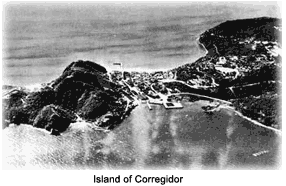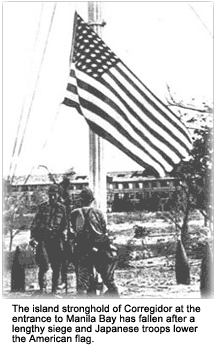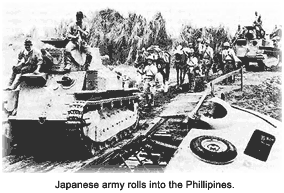Following the Pearl Harbor attack in December 1941, the Japanese invaded the Philippine Islands. The American-Filipino military force under the command of General Douglas MacArthur was pushed onto the Bataan peninsula, where they carried out a delaying action.


The Japanese knew that with enough force, they could take American- and Filipino-occupied Corregidor, a small rock-strewn island south of Bataan. Corregidor was strategically located at the entrance of Manila Bay, one of Asia's finest natural harbors. Like the stopper of a bottle, control of Corregidor meant control of the bay.
It was from Corregidor that Philippine President Manuel Quezon and General MacArthur left for Australia in March 1942, leaving Lt. General Jonathan M. Wainwright in overall command. Wainwright was the commander of the Filipino-American forces on the Island of Luzon, the island of Manilla and Manilla Bay.
On the 29th of December, the Japanese commenced their attacks on the island's massive fortifications.

It was not until early February that Japanese artillery opened fire on Corregidor. All of the fortifications sustained damage and part of the Malinta Tunnel on the island was breached, killing 28 men. The bombing also continued and the Japanese increased the amount they were firing on three nearby island forts. The enemy had experience with island warfare and had camouflaged his guns, making it nearly impossible for the Americans to aim at any targets.
The capitulation on Bataan on April 9 resulted in the seizure of thousands of Americans and Filipinos who would be forced to begin the infamous Bataan Death March, to the hellhole called Camp O'Donnell
On May 3, General Wainwright sent a message to MacArthur in Australia: “Situation here is fast becoming desperate.”
On May 6 at noon, Wainwright made the decision to surrender Corregidor, because of the lack of supplies and the losing battle. Bleakly, the American flag was lowered and replaced with a white flag.
Even after so many officers and men had surrendered, some did not want to give up, and remained behind to fight. The Japanese eventually called off their attacks and were satisfied with their current count of prisoners of war. The Corregidor garrison did not participate in the Death March. They were taken to Manilla where they were put on parade, and then by train to Prison Camp Cabanatuan in the Philippines.
Survivor
In 1965 I was stationed in Pensacola, FL at the US Naval Communication School command and was admitted to the
Hospital at Pensacola Naval Air Station for 30 days. There I met a wonderful person by the name of Arthur Golightly of whom I found was a survivor of
the Battle of Corregidor. He related to me the following story.
When the Japanese attacked the garrison at Corregidor one of the first things the artillery hit was the large freezer buildings which held all of their frozen
 meats and other frozen foods. Since the food would soon spoil the cooks were serving steak, turkey, and chicken for all three daily meals and were even
keeping the chow halls open 24 hours a day and you could stop anytime you wanted for a complete meal. Mr. Golightly said that most of the soldiers even
gained weight during the early days of the battle. Of course as the fighting went on and continued for over a month the food supply slowly dwindled.
By the time that they were over run by shear numbers General Wainwright was forced to surrender to keep from complete annihilation and to save the lives of
the earlier Bataan death march who the Japanese had threatened to execute if Wainwright did not surrender his command.
meats and other frozen foods. Since the food would soon spoil the cooks were serving steak, turkey, and chicken for all three daily meals and were even
keeping the chow halls open 24 hours a day and you could stop anytime you wanted for a complete meal. Mr. Golightly said that most of the soldiers even
gained weight during the early days of the battle. Of course as the fighting went on and continued for over a month the food supply slowly dwindled.
By the time that they were over run by shear numbers General Wainwright was forced to surrender to keep from complete annihilation and to save the lives of
the earlier Bataan death march who the Japanese had threatened to execute if Wainwright did not surrender his command.
Mr. Golightly told me that when he was captured he and his fellow troops were forced to march to the sea port where they were placed on cargo vessels
enroute to northern China. When he was loaded on the ship he found that the ship's hold was full of salt. They had to sleep, eat what little was given to them
and remain on top of a pile of salt. Before he was off loaded at a Chinese port he had disposed of his gas mask and had filled the bag full of salt. He remembered
as a child he had been told that if you did not have salt you would die. He managed to ration his salt and it lasted him for several years and he said
that he had just run out of salt a couple months before he was released. He, like several POWs I have talked to just did not want to discuss the conditions
in the POW camps.
Mr. Golightly had a wonderful sense of humor and a very bright outlook on life when I knew him, although he had suffered with Cancer for several years and
was 70 years old when I met him. He was still in the hospital when I was released to return to duty but I have always wandered just where he went and when
he died. I guess I may never know. He is one of those people that you are privileged to meet during your life time.
I have been fortunate to find the following:
Name: Arthur Golightly
Branch of Service: Coast Artillery Corps
Rank: First Sergeant
Service Number: 39459
Sub Unit: F Battery
Assigned Unit: 59th Coast Artillery Regiment
Parent Unit: Habor Defenses of Manila and Subic Bays
Source: 59th CA Regt roster of March 31 1941 - Corregidor Historical Society
Arthur Lewis Golightly
Birth Date: 7 Jul 1896
Birth Place: Edwardsville, Pennsylvania
Residence: Luzerne, Pennsylvania
|
With a little more research I have fond the following:
1910 Census Philadephia, PA
April 1910 Girard College Boarding School
Arthur L. Golightly age 13 Student
1930 Census Wilkes Barre City, PA
April 11, 1930
John May Head age 59
Elizabeth May wife age 59
Arthur Golightly son-in-law age 34
Helen Golightly daughter age 30
Meriam Golightly grand daughter age 3 2/12
Charles Golightly grand son age 10/12
1940 Census Wilkes Barre, PA
April 12, 1940
Arthur Golightly Head age 43 occ. Inspector, State Department
Helen Golightly wife age 40 Occ. Seamtress Dress Shop
Meriam Golightly daughter age 13
Charles Golightly son age 10
I have researched further and found the following obituary listed on "Find A Grave"
Arthur L. Golightly Death Victim at 71
Arthur L. Golightly, 71, of 23 South Hancock Street, died Saturday in Mercy Hospital where he was a patient two days. He was born in Edwardsville July 7, 1896, was graduated from Girard College and studied civil engineering.
He was the brother of Rev. Dr. William D. Golightly, pastor emeritus of the Emmanuel Baptist Church of Scranton.
Prior to his retirement, he was employed as electrical inspector with the Kearfoot Manufacuring Corporation in Little Falls, N. J. He also had been resident engineer in charge of construction for the Pittsburgh district of the Pennsylvania Turnpike Authority. For seven years, he was sales representative for Sunshine Biscuit locally.
Vice president of the Wilkes-Barre Blind Federation, he was an ardent bowler and won several trophies from the Wyoming, Valley Blind Bowlers Association.
During World War 2, he resided in La Porte. Ind. A member of St. Mark's Lutheran Church, he belonged to its men's organization, and held membership in Excelsior Lodge 41, F&AM, La Porte, Ind.
Surviving in addition to his brother are his wife, the former Helen May, past president of the local council, ILGWU; children, Mrs. Herman Baumann Jr , Wis.; Charles E. Pelham, N. IL; and four grandchildren.
Funeral will be from the Kniffen Funeral Home, 465 South Main Street. Tuesday morning at 11. Officiating will be the Rev. Calvin E. Humbert. Burial will be in Hollenback cemetery. Friends may call today 2 to 4 and 7 to 9. Masonic services will he held tonight at 8 by Lodge 61.
(Wilkes-Barre Record, 8 Jul 1968)
For more information click on "Corregidor".
Corregidor
Return to My Stories Page